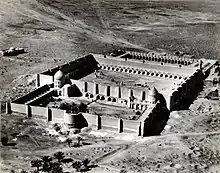Hafs
Abū ‘Amr Ḥafs ibn Sulaymān ibn al-Mughīrah ibn Abi Dawud al-Asadī al-Kūfī (Arabic: أبو عمر حفص بن سليمان بن المغيرة الأسدي الكوفي), better known as Hafs (706–796 CE; 90–180 AH according to the Islamic calendar),[1][2] is a significant figure in the art of Qur'an reading and variant recitations (qira'at). Being one of the primary transmitters of one of the seven canonical methods of Qur'an recitation, his method via his teacher Aasim ibn Abi al-Najud has become the most popular method across the majority of the Muslim world.[3]
Abu ‘Amr Hafs ibn Sulayman al-Asadi al-Kufi | |
|---|---|
حفص | |
| Personal | |
| Born | AD 706 |
| Died | AD 796 (aged 89–90) |
| Religion | Sunni Islam |
| Home town | Makkah |
| Parents |
|
| Senior posting | |
| Teacher | Aasim ibn Abi al-Najud |
In addition to being the student of Aasim, Hafs was also his son-in-law.[4] Having been born in Baghdad, Hafs eventually moved to Mecca where he popularized his father-in-law's recitation method.[4]
Eventually, Hafs' recitation of Aasim's method was made the official method of Egypt,[5] having been formally adopted as the standard Egyptian printing of the Qur'an under the auspices of Fuad I of Egypt in 1923.[4] The majority of copies of the Quran today follow the reading of Hafs. In North and West Africa there is a bigger tendency to follow the reading of Warsh.[6]
Hafs recitation

Of all the canonical recitation traditions, only the Kufan tradition included the basmala as a separate verse in Chapter (surah) 1.[7]
In the 10thC, in his Kitāb al-sabʿa fī l-qirāʾāt, Ibn Mujahid established seven readings of the Quran which would later be known as the canonical 'Seven'. Three of their readers hailed from Kufa, a centre of early Islamic learning.[8] The three Kufan readers were Al-Kisa'i, the Kufan; Hamzah az-Zaiyyat; and Aasim ibn Abi al-Najud.
It is, alongside the Hafs 'an 'Asim tradition which represents the recitational tradition of Kufa, one of the two major oral transmission of the Quran in the Muslim World.[9] The influential standard Quran of Cairo that was published in 1924 is based on Hafs 'an ʻAsim's recitation.
See also
References
- Muhammad Ghoniem and MSM Saifullah (8 Jan 2002). "The Ten Readers & Their Transmitters". Islamic Awareness. Retrieved 11 Apr 2016.
- Shady Hekmat Nasser (2012). "Ibn Mujahid and the Canonization of the Seven Readings". The Transmission of the Variant Readings of the Qur'an: The Problem of Tawaatur and the Emergence of Shawaadhdh. Leiden: Brill Publishers. p. 129. ISBN 9789004240810.
- Bewley, Aishah. "The Seven Qira'at of the Qur'an" Archived 2006-05-01 at the Wayback Machine, Aisha Bewley's Islamic Home Page
- Peter G. Riddell, Early Malay Qur'anic exegical activity, p. 164. Taken from Islam and the Malay-Indonesian World: Transmission and Responses. London: C. Hurst & Co., 2001. ISBN 9781850653363
- Cyril Glasse, The New Encyclopedia of Islam, p. 268. Intr. by Huston Smith. Lanham: Rowman & Littlefield, 2003. ISBN 9780759101906
- Aisha Geissinger, Gender and Muslim Constructions of Exegetical Authority: A Rereading of the Classical Genre of Qurʾān Commentary, pg. 79. Leiden: Brill Publishers, 2015. ISBN 9789004294448
- Stefan Wild, Al-Baydawi. Quran: an Encyclopedia
- Dutton, Yasin (2012). "Orality, Literacy and the 'Seven Aḥruf' Ḥadīth". Journal of Islamic Studies. 23 (1): 1–49. doi:10.1093/jis/etr092. ISSN 0955-2340. JSTOR 26201011.
- Ibn Warraq, Which Koran? Variants, Manuscript, Linguistics, pg. 45. Prometheus Books, 2011. ISBN 1591024307